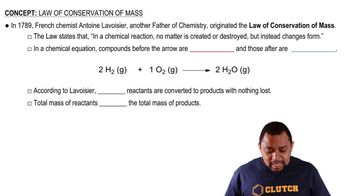An automobile gasoline tank holds 42 kg of gasoline. When the gasoline burns, 168 kg of oxygen is consumed, and carbon dioxide and water are produced. What is the total combined mass of carbon dioxide and water that is produced?
Upon decomposition, one sample of magnesium fluoride produces 1.65 kg of magnesium and 2.57 kg of fluorine. A second sample produces 2.72 kg of magnesium. How much fluorine (in grams) does the second sample produce?
 Verified step by step guidance
Verified step by step guidance
Verified video answer for a similar problem:
Key Concepts
Stoichiometry

Law of Conservation of Mass

Molar Mass

Two samples of carbon tetrachloride are decomposed into their constituent elements. One sample produces 38.9 g of carbon and 448 g of chlorine, and the other sample produces 14.8 g of carbon and 134 g of chlorine. Are these results consistent with the law of definite proportions? Explain your answer.
The mass ratio of sodium to fluorine in sodium fluoride is 1.21:1. A sample of sodium fluoride produces 45.1 g of sodium upon decomposition. How much fluorine (in grams) forms?
Two different compounds containing osmium and oxygen have the following masses of oxygen per gram of osmium: 0.168 and 0.3369 g. Show that these amounts are consistent with the law of multiple proportions.
Palladium forms three different compounds with sulfur. The mass of sulfur per gram of palladium in each compound is listed here. Show that these masses are consistent with the law of multiple proportions. Compound Grams S per Gram Pd A 0.603 B 0.301 C 0.151
